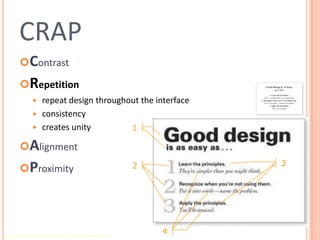Principles Of Effective Design
- 1. Principles of Effective Design:Joshua Tree Epiphany & CRAPEdited & adapted by Barbara B. NixonGeorgia Southern University
- 2. The Joshua Tree Epiphany
- 3. CRAPcontrast, repetition, alignment, proximityMajor sources: Designing Visual Interfaces, Mullet & Sano, Prentice Hall / Robin Williams Non-Designers Design Book, Peachpit PressSlide deck by Saul Greenberg. Permission is granted to use this for non-commercial purposes as long as general credit to Saul Greenberg is clearly maintained. Warning: some material in this deck is used from other sources without permission. Credit to the original source is given if it is known.
- 5. CRAPContrast Repetition Alignment Proximity Robin Williams Non-Designers Design Book, Peachpit Press
- 6. CRAPContrastmake different things differentbrings out dominant elementsmutes lesser elementscreates dynamismRepetition Alignment Proximity 12345Robin Williams Non-Designers Design Book, Peachpit Press
- 7. CRAPContrast Repetition repeat design throughout the interfaceconsistencycreates unity Alignment Proximity1324Robin Williams Non-Designers Design Book, Peachpit Press
- 8. CRAPContrast RepetitionAlignmentcreates a visual flowvisually connects elementsProximity1324Robin Williams Non-Designers Design Book, Peachpit Press
- 9. CRAPContrast Repetition Alignment Proximitygroups related elementsseparates unrelated ones123Robin Williams Non-Designers Design Book, Peachpit Press
- 10. Wheredoesyoureye go?CRAP combines to give you cues of how to read the graphictitlesubtextthree pointsmain pointsub pointRobin Williams Non-Designers Design Book, Peachpit Press
Editor's Notes
- NOTE: The original slide deck by Saul Greenberg. Permission was granted to use this for non-commercial purposes as long as general credit to Saul Greenberg is clearly maintained. Warning: some material in this deck is used from other sources without permission. Credit to the original source is given if it is known.
- Image Credit: http://www.flickr.com/photos/40871351@N00/407364383/The Joshua Tree Epiphanyby Robin WilliamsFound at http://pushingposes.blogspot.com/2008/03/perception-is-reality.html Once upon a time, Robin received a tree identifying book where you could match a tree up with its name by looking at its picture. Robin decided to go out and identify the trees in the neighborhood. Before she went out, she read through part of the book. The first tree in the book was the Joshua tree because it only took two clues to identify it.Now the Joshua tree is a really weird-looking tree and she looked at that picture and said to herself, "Oh, we don’t have that kind of tree in Northern California. That is a weird-looking tree. I would know if I saw that tree, and I’ve never seen one before."So she took the book and went outside. Her parents lived in a cul-de-sac of six homes. Four of those homes had Joshua trees in the front yard. She had lived in that house for thirteen years, and she had never seen a Joshua tree.She took a walk around the block - at least 80 percent of the homes had Joshua trees in the front yards. And she had sworn she had never seen one before!The moral of the story? Once Robin was conscious of the tree, once she could name it, she saw could see it everywhere. Which is exactly my point. Once you can name something, you’re conscious of it. You have power over it. You own it. You’re in control.-- end quote ---










